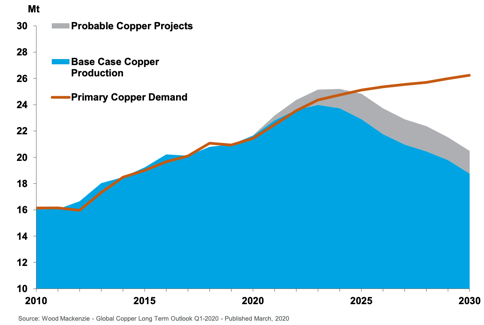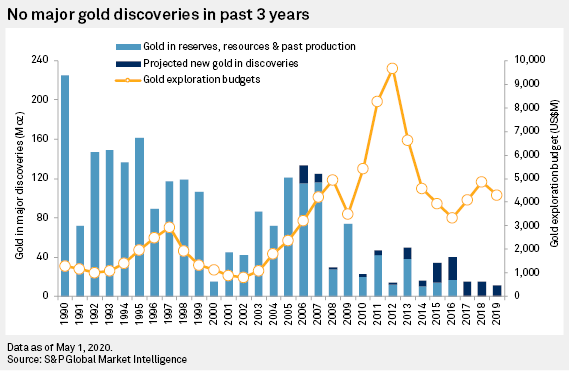Commodity Price Drivers
As a follow-up to our discussion last week on strategies to navigate the boom and bust of commodity cycles, this week we examine what drives commodity prices (primarily gold, copper, & battery metals) on the macro level. In terms of gold and copper, since the inception of the Resource Fund (July 2018), our long-term thesis has been supply-driven on the basis that major mining companies are having difficulty replacing dwindling reserves.
In conjunction, especially with copper, we see an increase in the demand outlook led by the expected growth of the Chinese economy (accounts for 50% of global consumption), demand for infrastructure, and anticipated growth of the Electric Vehicle market against a backdrop of tightening supply. By 2024, demand is set to outpace supply following a decade of lack of investment in exploration resulting in a dearth of high-quality development projects. Similarly, with gold there have been very few significant new gold discoveries compared to the mega-discoveries (+30Moz) of the past. Thus, the largest challenge for producers is reserve replacement.

While doctor copper’s outlook is largely based on tangible fundamentals (supply & demand), gold drivers are less definitive. As mentioned, gold discoveries have declined but there are other factors to consider as well. Gold’s recent performance can partly be attributed to inflationary pressures from recent stimulus packages leading to a weaker US dollar. As such, gold is typically considered a safe-haven asset and rallies during periods of uncertainty and against a falling US dollar.

In terms of battery metals (nickel, vanadium & lithium) our thesis here is demand based as the growth in the EV sector has underpinned the rapid growth in battery technologies. Currently the market is equipped to meet demand by increasing output; however, the need for high quality battery grade commodities could possibly bring on a tightening of the supply demand balance resulting in price spikes.
“This means that” there are many factors affecting what drives commodities. We can use these fundamental indicators to position ourselves into different commodities; however, our main investment thesis is anchored towards what the business is worth and what we know. With regards to what we know, that will be the subject of our upcoming Outlooks as we discuss different ore deposits and their key characteristics.
National Instrument 31-103 requires registered firms to disclose information that a reasonable investor would expect to know, including any material conflicts with the firm or its representatives. Doug Johnson and/or Pathfinder Asset Management Limited are an insider of companies periodically mentioned in this report. Please visit www.paml.ca for full disclosures.
*All returns are time weighted and net of investment management fees. Returns from the Pathfinder Partners’ Fund and Partners’ Real Return Plus Fund are presented based on the masters series of each fund. The Pathfinder Core: Equity Portfolio and The Pathfinder Core: High Income Portfolio are live accounts. These are actual accounts owned by the Pathfinder Chairman (Equity) and client (High Income) which contain no legacy positions, cash flows or other Pathfinder investment mandates or products. Monthly inception dates for each fund and portfolio are as follows: Pathfinder North American: Equity Portfolio (January 2011), Pathfinder North American: High Income Portfolio (October 2012) Pathfinder Partners’ Fund (April 2011), Pathfinder Real Return Plus Fund (April, 2013), Pathfinder International Fund (November 2014) and Pathfinder Resource Fund (May 2018).
Pathfinder Asset Management Limited (PAML) and its affiliates may collectively beneficially own in excess of 10% of one or more classes of the issued and outstanding equity securities mentioned in this newsletter. This publication is intended only to convey information. It is not to be construed as an investment guide or as an offer or solicitation of an offer to buy or sell any of the securities mentioned in it. The author has taken all usual and reasonable precautions to determine that the information contained in this publication has been obtained from sources believed to be reliable and that the procedures used to summarize and analyze such information are based on approved practices and principles in the investment industry. However, the market forces underlying investment value are subject to sudden and dramatic changes and data availability varies from one moment to the next. Consequently, neither the author nor PAML can make any warranty as to the accuracy or completeness of information, analysis or views contained in this publication or their usefulness or suitability in any particular circumstance. You should not undertake any investment or portfolio assessment or other transaction on the basis of this publication, but should first consult your portfolio manager, who can assess all relevant particulars of any proposed investment or transaction. PAML and the author accept no liability of any kind whatsoever or any damages or losses incurred by you as a result of reliance upon or use of this publication.